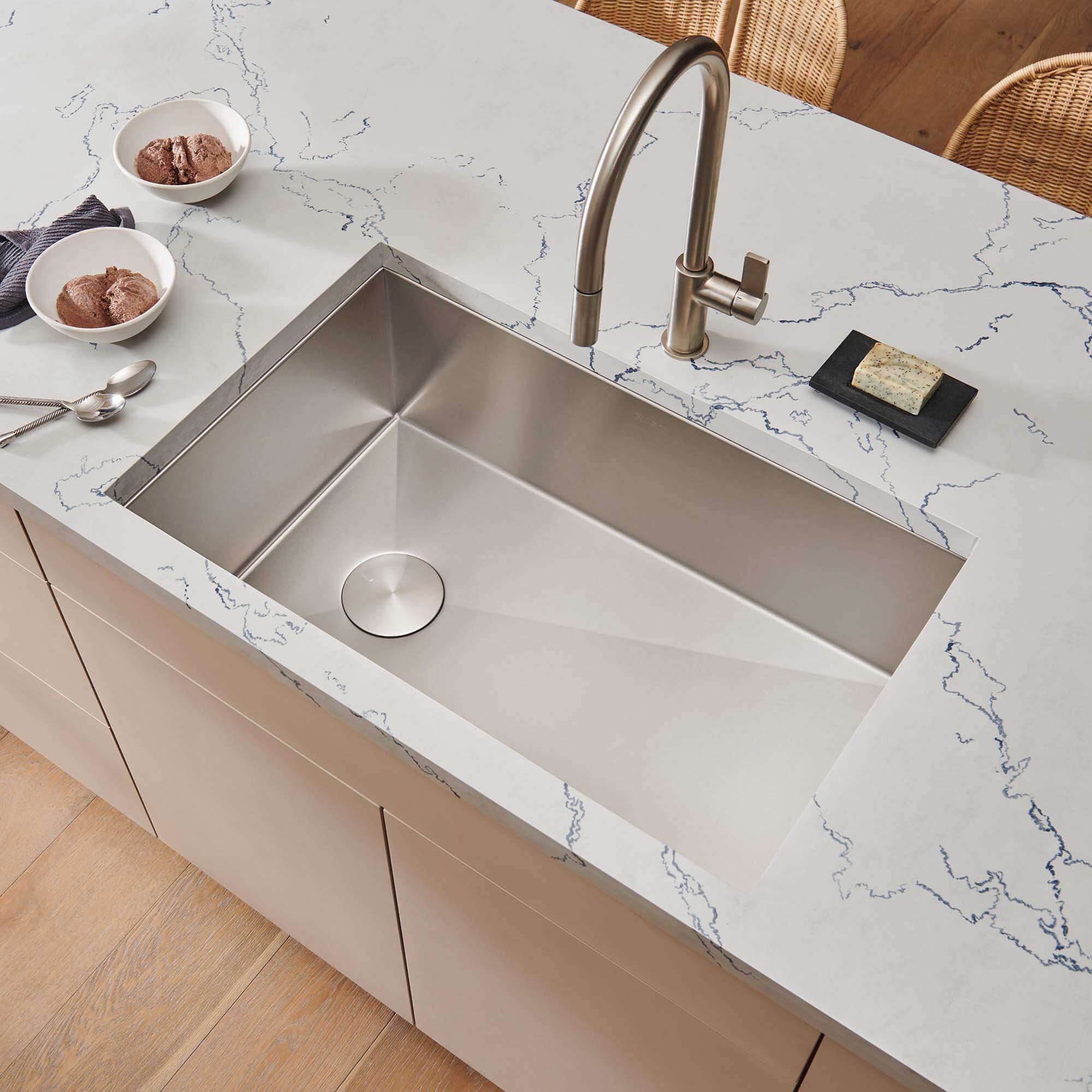Kitchen sinks can seem surprisingly costly. Kitchen sink price factors include the material, size, features, brand, and installation complexity. A kitchen renovation budget often has a significant portion allocated to the sink. This article breaks down why you might encounter a higher average kitchen sink cost than expected, helping you make informed choices.

Image Source: www.ruvati.com
Decoding Kitchen Sink Pricing
Many elements determine the final price of a kitchen sink. Let’s examine these sink features impacting price one by one.
Sink Material Cost: The Foundation of Price
The sink material cost is a significant driver of overall price. Different materials offer varying levels of durability, aesthetics, and functionality.
- Stainless Steel: This is a popular choice for its durability, resistance to stains and heat, and relatively lower price point. However, the gauge (thickness) of the stainless steel influences the cost. Lower gauge (thicker) steel is more expensive and more resistant to dents and noise.
- Granite Composite: Made from a mix of granite stone dust and acrylic resins, these sinks are incredibly durable and resistant to scratches, stains, and heat. They are typically more expensive than stainless steel.
- Fireclay: This material involves firing clay at extremely high temperatures, resulting in a very durable and non-porous surface. Fireclay sinks are often farmhouse-style sinks and come with a higher price tag.
- Cast Iron: Typically coated with enamel, cast iron sinks are durable and heavy. They can chip or stain over time, and they tend to be more expensive than stainless steel.
- Copper: Known for its antimicrobial properties and unique aesthetic, copper sinks are a premium option. The price reflects the cost of the material and the specialized craftsmanship involved in their production.
Size and Configuration: More Material, More Money
The size and configuration of the sink also impact the price. Larger sinks with multiple basins require more material and more complex manufacturing processes.
- Single Bowl: The most basic and often least expensive option.
- Double Bowl: Offers separate basins for washing and rinsing, increasing functionality and typically the price.
- Triple Bowl: Provides even more workspace and versatility but comes with a higher cost and space requirement.
- Farmhouse/Apron Front: These sinks feature an exposed front apron and are typically larger and more expensive due to their design and the modifications needed for cabinet installation.
Features: Adding Functionality Adds to the Price
Extra features can significantly increase the kitchen sink price factors. Consider what features are important to you and how they fit into your kitchen renovation budget.
- Sound Dampening: Pads or coatings applied to the underside of the sink to reduce noise from running water and clanging dishes.
- Strainers and Grids: High-quality stainless steel strainers and bottom grids add to the convenience and longevity of the sink.
- Cutting Boards and Colanders: Some sinks come with integrated accessories like cutting boards or colanders that fit snugly over the sink, adding to their functionality and price.
- Faucet Holes: The number and configuration of faucet holes can also affect the price, as some sinks require custom drilling.
Brand Reputation: Paying for Quality and Design
High-end sink brands often command a premium price due to their reputation for quality, innovative designs, and superior customer service.
- Kohler: A well-known brand offering a wide range of sinks in various materials and styles.
- Elkay: Specializes in stainless steel sinks and offers a variety of configurations and features.
- Franke: A Swiss brand known for its high-quality stainless steel and granite composite sinks.
- Ruvati: Offers a range of sinks with modern designs and innovative features.
Sink Installation Costs: A Hidden Expense
Don’t forget to factor in sink installation costs when planning your kitchen renovation budget. The complexity of the installation can vary depending on the sink type and existing plumbing.
- Drop-in/Top Mount: The easiest and least expensive type to install, as it simply drops into a pre-cut hole in the countertop.
- Undermount: Requires more precise countertop cutting and professional installation, as the sink is mounted underneath the countertop.
- Farmhouse/Apron Front: The most challenging and expensive to install, as it often requires modifications to the base cabinets.
The table below summarizes typical installation costs:
| Sink Type | Typical Installation Cost |
|---|---|
| Drop-in/Top Mount | \$150 – \$300 |
| Undermount | \$250 – \$500 |
| Farmhouse/Apron Front | \$400 – \$800+ |
Durable Sink Materials: Long-Term Investment
Choosing durable sink materials is crucial for ensuring the longevity of your sink and avoiding costly replacements down the line. While initially more expensive, durable materials can save you money in the long run.
- Stainless steel (16-18 gauge): Resists dents and corrosion.
- Granite composite: Highly resistant to scratches, stains, and heat.
- Fireclay: Extremely durable and non-porous.
Grasping the Cost of Luxury
Luxury kitchen sink options go beyond basic functionality and offer premium materials, unique designs, and advanced features.
- Handcrafted Copper Sinks: Offer a unique aesthetic and antimicrobial properties.
- Custom-Designed Sinks: Tailored to your specific needs and preferences, often involving unique materials and configurations.
- Sinks with Integrated Workstations: Feature built-in cutting boards, colanders, and other accessories for maximum efficiency.
Navigating the Kitchen Sink Market: A Kitchen Sink Buying Guide
This kitchen sink buying guide will help you navigate the complexities of the market. Consider the following factors when making your purchase:
- Budget: Determine how much you’re willing to spend on a sink, including installation costs.
- Size and Configuration: Choose a size and configuration that meets your needs and fits your kitchen layout.
- Material: Select a material that offers the durability, aesthetics, and functionality you desire.
- Features: Consider which features are important to you and how they will enhance your kitchen experience.
- Installation: Factor in the installation costs and choose a sink type that is compatible with your countertop and cabinets.
The Kitchen Sink Spectrum: Budget to High-End
To give you a clearer picture, here’s a breakdown of the average kitchen sink cost across different price ranges:
| Price Range | Material | Features | Installation | Example |
|---|---|---|---|---|
| Budget (\$100-\$300) | Stainless Steel (20-22 gauge) | Basic single or double bowl | Drop-in | Standard stainless steel sink |
| Mid-Range (\$300-\$700) | Stainless Steel (18-20 gauge), Granite Composite | Sound dampening, strainers | Undermount or Drop-in | Elkay Quartz Classic |
| High-End (\$700+) | Stainless Steel (16-18 gauge), Fireclay, Copper | Integrated accessories, custom designs | Farmhouse/Undermount | Kohler Whitehaven Farmhouse Sink, Ruvati Workstation |
Examples of Kitchen Sinks from Different Brands
Here are a few examples of kitchen sinks from different brands, along with their price points and key features:
| Brand | Model | Material | Price (Approx.) | Key Features |
|---|---|---|---|---|
| Elkay | Lustertone Classic Single Bowl | Stainless Steel | \$200 | Durable, scratch-resistant finish, sound dampening |
| Kohler | Whitehaven Farmhouse Apron Front | Enameled Cast Iron | \$1,200 | Classic farmhouse style, durable, easy to clean |
| Franke | Pescara Granite Composite Double Bowl | Granite Composite | \$500 | Heat resistant, scratch resistant, non-porous |
| Ruvati | Roma Workstation Ledge Single Bowl | Stainless Steel | \$800 | Integrated cutting board and colander, sound dampening, commercial grade brushed finish |
| Kraus | Forteza Drop-In Top Mount | Stainless Steel | \$150 | Cost-effective, easy to install, durable stainless steel |
| Bocchi | Vello Farmhouse Apron Front | Fireclay | \$950 | Extremely durable, stain-resistant, classic farmhouse design |
| Native Trails | Farmhouse Copper Single Basin | Hammered Copper | \$1,500 | Handmade, antimicrobial properties, unique aesthetic, adds a touch of rustic elegance |
Key Takeaways
The price of a kitchen sink depends on several factors, including the material, size, features, brand, and installation complexity. By assessing your needs, setting a budget, and doing your research, you can find a sink that meets your requirements and enhances your kitchen’s functionality and aesthetics without breaking the bank.
Frequently Asked Questions (FAQ)
-
What is the most durable material for a kitchen sink?
Granite composite and fireclay are generally considered the most durable materials, offering excellent resistance to scratches, stains, and heat.
* Can I install a kitchen sink myself?While it is possible to install a drop-in sink yourself, undermount and farmhouse sinks are best left to professional plumbers due to the complexity of the installation.
* Who is a good sink installer?A licensed plumber with experience installing the specific type of sink you’ve chosen is the best choice. Check online reviews and ask for references.
* What is the ideal sink depth?A sink depth of 8-10 inches is generally considered ideal for most kitchens, providing ample space for washing dishes and preventing splashing.
* What are the benefits of a workstation sink?Workstation sinks increase efficiency by providing integrated cutting boards, colanders, and other accessories, allowing you to prep food directly over the sink.
* How can I maintain my kitchen sink to prolong its life?Regular cleaning with appropriate cleaning products, avoiding abrasive cleaners, and promptly addressing any leaks or damage can help prolong the life of your kitchen sink. For stainless steel, dry the sink after each use to avoid water spots.
* What is the best gauge of stainless steel for a kitchen sink?The lower the gauge, the thicker the steel. 16-18 gauge stainless steel is generally recommended for optimal durability and resistance to dents and noise.
* Are farmhouse sinks more expensive?Yes, farmhouse sinks are typically more expensive than other types of sinks due to their unique design, larger size, and more complex installation requirements.

Hi, I’m Larry Fish, the mind behind MyGrinderGuide.com.. With a passion for all things kitchen appliances, I created this blog to share my hands-on experience and expert knowledge. Whether it’s helping you choose the right tools for your culinary adventures or offering tips to make your kitchen more efficient, I’m here to guide you. My goal is to make your time in the kitchen not only easier but also enjoyable! Welcome to my world of kitchen mastery!
